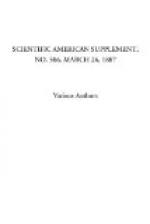The author next referred to the great excellence for chilling purposes possessed by some American pig irons, and to the fact that iron of a given carbon content derived from some ores and fluxes differed much in chilling properties from iron holding a similar proportion of carbon—free and combined—derived from other ores and materials. Those irons are best which develop the hardest possible chill most uniformly to the desired depth without producing a too abrupt line of division between the hard white skin and the softer gray body. A medium shading off both ways is wanted here, as in all things. The impossibility of securing a uniform quality and chemical composition in any number grade of any brand of pig iron over a lengthened period was adverted to. Consequent from this a too resolute faith in any particular make of pig iron is likely to be at times ill-requited. Occasional physical tests, accompanied with chemical analysis of irons used for chilling, were advocated; and the author was of opinion it would be well whenever a chilled casting had enjoyed a good reputation for standing up to its work, that when it was retired from work some portions of it should be chemically analyzed so as to obtain clews to compositions of excellence. Some of the physical characteristics of chilled iron, as well as the surprising locomotive properties of carbon present in heated iron, were noticed.




